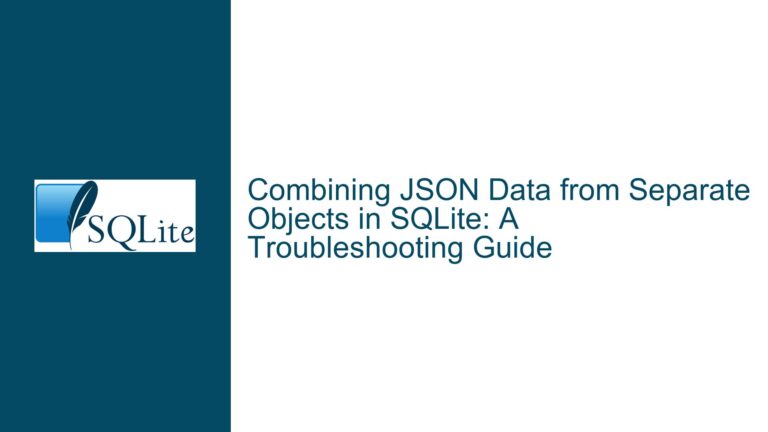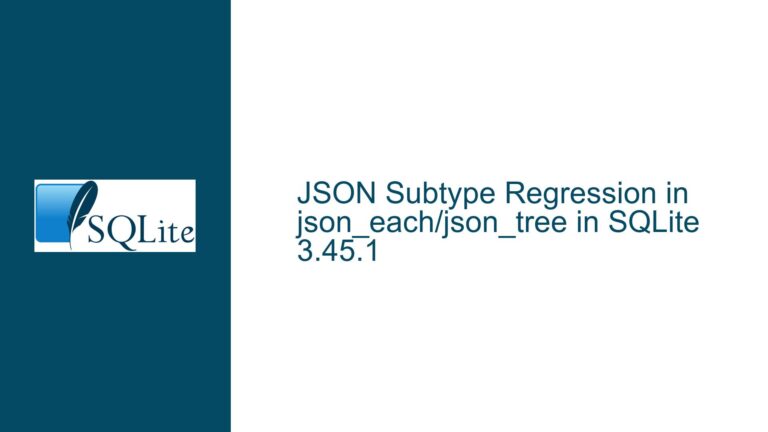Unexpected Row Filtering by DISTINCT in RIGHT JOIN with UNIQUE Constraint
Issue Overview: DISTINCT Filtering Rows in RIGHT JOIN with UNIQUE Constraint
The core issue revolves around the unexpected behavior of the DISTINCT keyword when used in conjunction with a RIGHT JOIN operation on tables where one of the columns involved in the join has a UNIQUE constraint. Specifically, the query returns an empty result set when DISTINCT is applied, whereas the same query without DISTINCT returns the expected rows. This behavior is particularly puzzling because it only manifests under specific conditions: when the RIGHT JOIN is used and the joined column in the left table has a UNIQUE constraint. If either of these conditions is altered—such as removing the UNIQUE constraint or changing the join type to LEFT JOIN—the issue disappears.
To understand the problem, let’s break down the schema and the query in question. The schema consists of three tables: t1, t2, and t3. Table t1 has a single column c0 with a UNIQUE constraint, while t2 and t3 have a single column c0 without any constraints. The data inserted into these tables is minimal: t1 contains the value 1, t2 contains 2, and t3 contains 3. The query in question performs a NATURAL JOIN between t2 and t1, followed by a RIGHT OUTER JOIN with t3 on the condition t1.c0. The first query without DISTINCT returns a single row with the value 3 from t3, while the second query with DISTINCT returns an empty set.
This behavior is counterintuitive because DISTINCT is typically used to eliminate duplicate rows from the result set, not to filter out all rows entirely. The fact that the presence of a UNIQUE constraint on t1.c0 and the use of a RIGHT JOIN are both necessary for the issue to occur suggests that there is an underlying interaction between these elements that is not immediately obvious. This issue is further complicated by the fact that it was identified as a bug in SQLite and subsequently fixed in the trunk version, indicating that it was a genuine anomaly in the SQLite engine’s handling of such queries.
Possible Causes: Interaction Between DISTINCT, RIGHT JOIN, and UNIQUE Constraint
The unexpected behavior of the DISTINCT keyword in this scenario can be attributed to the interplay between the RIGHT JOIN operation, the UNIQUE constraint on t1.c0, and the way SQLite handles the elimination of duplicate rows. To understand why this happens, we need to delve into the mechanics of how SQLite processes joins and the DISTINCT keyword.
First, let’s consider the RIGHT JOIN operation. A RIGHT JOIN returns all rows from the right table (t3 in this case), and the matched rows from the left table (t1 and t2). If there is no match, the result set will still include the rows from the right table, with NULL values for the columns from the left table. In the given query, the NATURAL JOIN between t2 and t1 produces an intermediate result set that is then joined with t3 using the RIGHT JOIN. Since t1 and t2 do not share any common values with t3, the RIGHT JOIN should return a single row from t3 with NULL values for the columns from t1 and t2.
Next, let’s examine the role of the UNIQUE constraint on t1.c0. The UNIQUE constraint ensures that all values in the c0 column of t1 are distinct. This constraint affects the way SQLite processes the join and the subsequent application of the DISTINCT keyword. When the RIGHT JOIN is performed, SQLite attempts to match rows based on the condition t1.c0. However, since t1.c0 is UNIQUE, and there is no matching value in t3, the join condition effectively fails, resulting in NULL values for t1.c0 in the result set.
The crux of the issue lies in how SQLite handles the DISTINCT keyword in this context. When DISTINCT is applied, SQLite attempts to eliminate duplicate rows from the result set. However, due to the UNIQUE constraint on t1.c0 and the RIGHT JOIN operation, the intermediate result set contains rows with NULL values for t1.c0. SQLite’s handling of NULL values in conjunction with the UNIQUE constraint and the DISTINCT keyword appears to be the source of the problem. Specifically, SQLite seems to incorrectly interpret the NULL values as duplicates, leading to the elimination of all rows from the result set.
This behavior is further corroborated by the fact that the issue disappears when the UNIQUE constraint is removed or when the join type is changed to LEFT JOIN. Removing the UNIQUE constraint allows SQLite to process the NULL values correctly, while changing the join type to LEFT JOIN alters the way the join condition is evaluated, preventing the issue from occurring.
Troubleshooting Steps, Solutions & Fixes: Addressing the DISTINCT and RIGHT JOIN Anomaly
To address the issue of DISTINCT unexpectedly filtering out all rows in a RIGHT JOIN with a UNIQUE constraint, several steps can be taken to diagnose and resolve the problem. These steps include verifying the SQLite version, understanding the query execution plan, and applying workarounds or fixes.
Step 1: Verify SQLite Version and Configuration
The first step in troubleshooting this issue is to verify the version of SQLite being used and its configuration. The issue was identified in SQLite version 3.39.0 and was subsequently fixed in the trunk version. Therefore, if you are experiencing this issue, it is essential to check whether you are using a version of SQLite that includes the fix. You can do this by running the following command in the SQLite CLI:
SELECT sqlite_version();
If the version returned is earlier than 3.39.0, or if it is a version where the fix has not been applied, you should consider upgrading to a newer version of SQLite that includes the fix. Additionally, it is important to ensure that the SQLite installation is configured correctly, as certain configuration options may affect the behavior of joins and the DISTINCT keyword.
Step 2: Analyze the Query Execution Plan
Understanding how SQLite processes the query can provide valuable insights into why the issue occurs. SQLite provides the EXPLAIN and EXPLAIN QUERY PLAN commands, which can be used to analyze the execution plan of a query. By running these commands on the problematic query, you can gain a better understanding of how SQLite is handling the RIGHT JOIN, the UNIQUE constraint, and the DISTINCT keyword.
For example, you can run the following command to analyze the query execution plan:
EXPLAIN QUERY PLAN
SELECT DISTINCT t1.c0, t3.c0 FROM t2 NATURAL JOIN t1 RIGHT OUTER JOIN t3 ON t1.c0;
The output of this command will show the order in which SQLite processes the tables and the join conditions. Pay particular attention to how SQLite handles the RIGHT JOIN and the DISTINCT keyword. If the execution plan indicates that SQLite is incorrectly interpreting the NULL values as duplicates, this would confirm the underlying cause of the issue.
Step 3: Apply Workarounds or Fixes
If upgrading to a fixed version of SQLite is not immediately feasible, there are several workarounds that can be applied to avoid the issue. These workarounds involve modifying the query or the schema to prevent the problematic interaction between the RIGHT JOIN, the UNIQUE constraint, and the DISTINCT keyword.
Workaround 1: Remove the UNIQUE Constraint
One straightforward workaround is to remove the UNIQUE constraint on t1.c0. This can be done by altering the table schema as follows:
CREATE TABLE t1 (c0 INTEGER);
By removing the UNIQUE constraint, SQLite will no longer treat NULL values as duplicates, allowing the DISTINCT keyword to function correctly. However, this workaround may not be suitable if the UNIQUE constraint is required for other reasons, such as ensuring data integrity.
Workaround 2: Change the Join Type
Another workaround is to change the join type from RIGHT JOIN to LEFT JOIN. This can be done by modifying the query as follows:
SELECT DISTINCT t1.c0, t3.c0 FROM t3 LEFT OUTER JOIN (t2 NATURAL JOIN t1) ON t1.c0;
By changing the join type, the way SQLite processes the join condition and the NULL values is altered, preventing the issue from occurring. However, this workaround may not be suitable if the RIGHT JOIN is required for the specific logic of the query.
Workaround 3: Use COALESCE to Handle NULL Values
A more nuanced workaround is to use the COALESCE function to handle NULL values explicitly. The COALESCE function returns the first non-NULL value in its list of arguments, which can be used to ensure that NULL values are treated consistently. For example, you can modify the query as follows:
SELECT DISTINCT COALESCE(t1.c0, -1), t3.c0 FROM t2 NATURAL JOIN t1 RIGHT OUTER JOIN t3 ON t1.c0;
In this modified query, COALESCE(t1.c0, -1) ensures that NULL values in t1.c0 are replaced with -1, preventing SQLite from incorrectly interpreting them as duplicates. This workaround allows the DISTINCT keyword to function correctly while preserving the UNIQUE constraint and the RIGHT JOIN.
Step 4: Upgrade to a Fixed Version of SQLite
The most effective long-term solution is to upgrade to a version of SQLite that includes the fix for this issue. As mentioned earlier, the issue was identified and fixed in the trunk version of SQLite. Therefore, upgrading to a version that includes this fix will resolve the issue without requiring any modifications to the query or the schema.
To upgrade SQLite, you can download the latest version from the official SQLite website and follow the installation instructions for your operating system. After upgrading, you should verify that the issue has been resolved by running the problematic query and confirming that it returns the expected results.
Conclusion
The unexpected filtering of rows by the DISTINCT keyword in a RIGHT JOIN with a UNIQUE constraint is a complex issue that arises from the interplay between SQLite’s handling of NULL values, the UNIQUE constraint, and the DISTINCT keyword. By understanding the underlying mechanics of these elements and applying the appropriate troubleshooting steps, you can diagnose and resolve the issue effectively. Whether through workarounds or upgrading to a fixed version of SQLite, the key is to ensure that the query and schema are configured in a way that avoids the problematic interaction.






